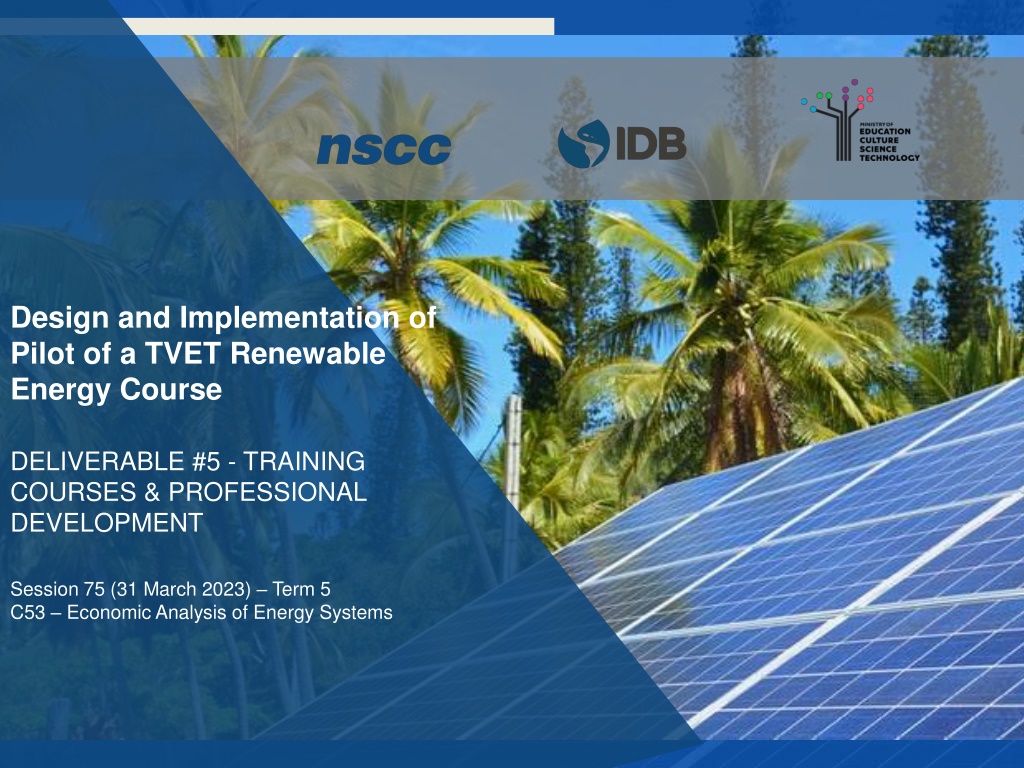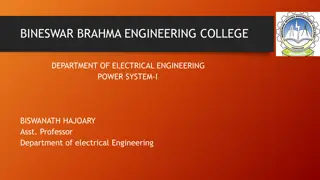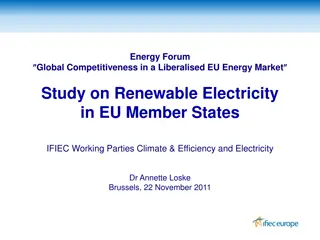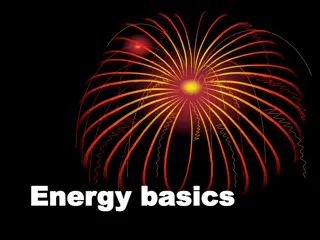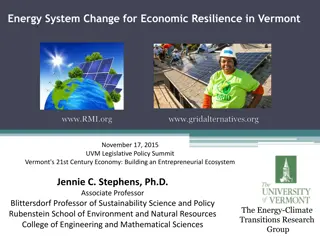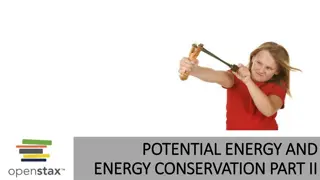Economic Analysis of Energy Systems Training Course Overview
This document outlines the details of Course C.53: Economic Analysis of Energy Systems, part of a TVET Renewable Energy program. It covers topics such as the economic analysis of system scenarios, financial performance comparison, and skills development for energy efficiency professionals. Success criteria include equipment handling, data analysis, and effective communication with stakeholders.
Download Presentation

Please find below an Image/Link to download the presentation.
The content on the website is provided AS IS for your information and personal use only. It may not be sold, licensed, or shared on other websites without obtaining consent from the author. Download presentation by click this link. If you encounter any issues during the download, it is possible that the publisher has removed the file from their server.
E N D
Presentation Transcript
Design and Implementation of Pilot of a TVET Renewable Energy Course DELIVERABLE #5 - TRAINING COURSES & PROFESSIONAL DEVELOPMENT Session 75 (31 March 2023) Term 5 C53 Economic Analysis of Energy Systems
For Today: 1. Renewable Energy and Energy Efficiency (RE EE) Program Overview 2. Description of Course 53 in Term 5 of Year 2 3. From TDAPS to Lesson Plans (incl. Master Plan, Pedagogical Materials) 4. Developing Course 53
C 53: Econ. Analysis of Ener. Syst. Overview and Description An introduction to the economic analysis of system scenarios and options having technical descriptions through the energy efficiency modeling, analysis, measurement and verification topics of earlier courses. Calculate and compare relative financial performance (e.g. rate of return and payback period ) of reasonably developed and competing potential energy system options or scenarios.
C 53: Econ. Analysis of Ener. Syst. C53 Course among other Energy Efficiency courses: C13 Introduction to Energy Science C23 Energy Modeling and Analysis C42 Energy Efficiency Measurement and Verification C53 Economic Analysis of Energy Systems C53 Economic Analysis of Energy Systems C62 Advanced Energy System Design
What does success look like? For Employers and the Energy Efficiency part of Program: Identification, selection, installation, operation, maintenance, of equipment and instruments Interpretation, analysis, conclusions, and recommendations from measurement data results Accounting for uncertainties, data gaps, and assumptions Verbal, written, & digital communications skills clients, residents, suppliers, partners, regulators, team members
C53 uses C42 Tech. Descriptions C 42; Energy Efficiency Measurement and Verification Examples of anticipated outcomes after course completion Propose equipment, instruments, methods, and procedures for target data in an energy efficiency project Calculate and compare relative financial performance (e.g. rate of return and payback period ) of reasonably developed and competing potential energy system options or scenarios.
C 53: Econ. Analysis of Ener. Syst. C 53: Econ. Analysis of Energy Systems At a glance For Energy System Scenarios A, B, C, and D (e.g. PV, Hot Water, Wind, and Efficiency), there is a net change in desired Energy (e.g. additionally produced or saved Watts) and a corresponding net change in costs (e.g. $$$ value of net change in Watts less scenario costs from design, construction, operations, & maintenance) Which scenario has the best ratio of net $$$ / Watts? Which scenario has the best ratio of net $$$ / Watts?
1. Program Overview (Partners) 1. Belize National Energy Policy Goals 2. Inter-American Development Bank (ADB) 3. Belize Ministry of Education (MOE) 4. ITVET Belize 5. Nova Scotia Community College (NSCC) Project Team
1. Program Overview (Project) 1. New Program Course Descriptions & Materials 2. Instructor Preparations & Professional Development 3. New Program Marketing and Promotion Support 4. Some New Lab Equipment 5. Implementation Plan 6. Capacity to scale up from Pilot Course
1. Program Overview (Courses) 2 Year (~32 Course) RE EE Program Overview 1st Year Term 1 Communi- cations 1 Comm 1 Communi- cations 2 Comm 2 Communi- cations 3 Comm 3 Audits 1 Customer Relations Audits 1 Applied Math 1 Math 1 Energy Model. and Analysis Ener M A Applied Math 2 Math 2 Energy Eff. Measure. & Verification E E M V Intro to Ener. Sci. Ener Sci Electricity and Circuits 2 Elec. Cir. 2 Solar Hot Water Systems Sol H W S PV Stand Alone System Design PV SASD PV Applications PV Appl Elec. and Circuits 1 Elec. Cir. 1 Integrated Lab 1 Int Lab 1 Integrated Lab 2 Int Lab 2 Technical Drawing Tec Dwg Sm. Wind Design & Operation Sm Wind Term 2 PV Grid Tied Design PV GT De PV Solar Panel Installations PV Instal PV Battery Based Installations PV Bat In Term 3 2nd Year Term 4 Term 5 Projects and Comms 1 Pro Comm Adv. Energy System Design AES Des Audits 2 Load Analysis Audits 2 Final Project (Classroom) Fin Proj Econ Analysis of Energy Systems Econ A E S Bus. Operations & Entrepreneurs. Bus O & E Elec. Codes and Regulations Elec C A R PV Sys. Maint. & Operation PV M & O Project Planning Proj Plan Final Proj. (Lab) Fin Pro Term 6
1. Program Overview (Term 5 Courses) January March (10 Weeks) 1. Projects and Communications 2. Audits 02 Load Analysis 3. 3. Economic Analysis of Economic Analysis of Energy Systems Energy Systems 4. Electrical Codes and Regulations 5. Project Plan (for C 63)
C 53: Econ Analysis of Energy Systems 1. 10 Week Term 5, Year 2 40 Classroom hours as 6 periods/wk. x 10 weeks (2 x Tue. am) + (2 x Tue. pm) + (2 x Wed. am) 0 New Lab hours 2. Marking Breakdown 25% Individual Tests 35% Individual Assign. 30% Group Projects 10% Employability Skills
C 53: Econ. Analysis of Ener. Syst. C 53: Econ. Analysis of Energy Systems Econ AES (in Calendar Table) (T1) Introduce concept of interest, investment, & loans (T 2) Introduce the concept of the time value of money (T 3) Identify the present and future value of single and repeated payments for different interest rates
C 53: Econ. Analysis of Ener. Syst. C 53: Econ. Analysis of Energy Systems Econ AES (in Calendar Table) (T 4) Identify the rate of return for energy systems and energy efficiency measures (T 5) Prepare and rank the relative benefit of potential energy system or efficient improvement decisions
C 53: Econ. Analysis of Ener. Syst. C 53: Econ. Analysis of Energy Systems Examples of anticipated outcomes after course completion Develop reasonable financial project scenarios for potential energy systems (e.g. PV, small wind, solar hot water, energy efficiencies) Calculate scenario rate of return & payback period Calculate & compare relative financial performance of competing potential energy system options / scenarios
C 53: Econ. Analysis of Ener. Syst. From Learning Outcomes and Tasks Task 01 Introduce concept of interest, investment, & loans Interest the rent on borrowed use of others $$ Investment scenario option with risks to spend $$ and receive $$$ or $ or zero or less ... over time Loans principal, interest, time, payments, security
C 53: Econ. Analysis of Ener. Syst. From Learning Outcomes and Tasks Task 02 Introduce the concept of the time value of money Present Worth (e.g. in 2023 of sum of annual $1000 payments over 5 years from 2024 - 2028) Future Worth (e.g. in 2028 of sum of annual $1000 payments over 5 years from 2024 - 2028) Account for varying interest and inflation rates
C 53: Econ. Analysis of Ener. Syst. From Learning Outcomes and Tasks Task 03 Identify the present and future value of single and repeated payments for different interest rates Present & Future Worth - single & series payments Account for fixed and for varying interest rates Account for stable and for varying inflation rates
C 53: Econ. Analysis of Ener. Syst. From Learning Outcomes and Tasks Task 04 Identify the rate of return for energy systems and energy efficiency measures For scenario options (e.g. A, B, C, D) calculate ratios of net $$$ per net change in Watts due to scenario Calculate when net $$ revenue pays Investment $$ Compare to option of $$ staying in a bank account
C 53: Econ. Analysis of Ener. Syst. From Learning Outcomes and Tasks Task 05 Prepare and rank the relative benefit of potential energy system or efficient improvement decisions For scenario options (e.g. A, B, C, D) compare and rank based on ratios of net $$ per change in Watts Rank by lifecycle net $ revenue to Investment $ Account for risks of varying interest & inflation rates
2. Description of Course 53 Marking Breakdown 25% Individual Tests 35% Individual Projects 30% Group Projects 10% Employability Skills
2. Description of Course 53 Marking Breakdown 25% Individual Tests (Examples) 9% Task 1 Introduce ... interest, investment, & loans 8% Task 2 Introduce concept ... time value of money 8 % Task 3 ... present & future value of payments for different interest rates 0% Task 4 Identify the rate of return . . . for scenarios 0% Task 5 ... rank the relative benefit ... of (options)
2. Description of Course 53 Marking Breakdown 35% Individual Projects (Examples) 0% Task 1 Introduce . . . interest, investment, & loans 5% Task 2 Introduce concept ... time value of money 15% Task 3 ... present & future value of payments for different interest rates 10% Task 4 Identify the rate of return ... for scenarios 5% Task 5 ... rank the relative benefit ... of (options)
2. Description of Course 53 Marking Breakdown 30% Group Projects (Examples) 0% Task 1 Introduce . . . interest, investment, & loans 0% Task 2 Introduce concept ... time value of money 0% Task 3 ... present & future value of payments for different interest rates 10% Task 4 Identify the rate of return ... for scenarios 20% Task 5 ... rank the relative benefit ... of (options)
2. Description of Course 53 Marking Breakdown 10% Employability Skills (Examples) Instructor selected (e.g. other ITVET Belize courses) Attendance Timeliness Attention to detail
2. Description of Course C53 C 53: Econ. Analysis of Ener. Syst. Instructor Comments? Instructor Discussion? Instructor Suggestions? Real World Applications?
3. From TDAPs to Lesson Plans Technical Delivery and Assessment Plan (TDAP) for each ITVET course includes a Delivery Schedule section Delivery Schedule includes places for Instructor to note the intended Teaching Method and Promotional Action Master Plan (Learning Outcomes) Pedagogical Materials Document includes Teaching Methods (TM) and Promotional Actions (PA)
3. From TDAPs to Lesson Plans Typical at ITVET For all courses By all Instructors For each term Training Delivery and Assessment Plan Profile of the Trainee / Portfolio of the Trainee Program Policies & Regulations / Technology Requirements Instructional Methods / Modes (Face to Face and Online) Resources (Technical; Underpinning Knowledge and Skills) Delivery Schedule (week / Instructional Methods (IM) Practical Grading Criteria and Theoretical Grading Criteria
3. From TDAPs to Lesson Plans Typical at ITVET For all courses By all Instructors For each term Delivery Schedule Delivery Schedule (The basis for the Lesson Plans!?) For each Week or ?? week period, the Course Outline Topic (e.g. Present worth of series of payments) and Tasks Instructional Methods (IM) (e.g. Collaborative Discussions) Promotional Action (PA) (e.g. Practice work sheets, games) Assessment Method (e.g. Test 1, Assignment 1, Project 1) Resources (e.g. Textbook, Videos, Worksheet, Powerpoint)
3. From TDAPs to Lesson Plans From Master Plan, Learning Outcomes 8, 9. and 10 8 Impact of renewable energy on society and the environment 9 Ethics and equity 10 Economics and project management
3. From TDAPs to Lesson Plans Master Plan Learning Outcome 8 Impact of Renewable Energy (RE) on society and the environment An ability to analyze aspects of RE activities. This includes an understanding of the interactions that RE projects have with the economic, societal, health, safety, legal, and cultural aspects of society; the uncertainties in the prediction of such interactions; and sustainable design and development, and environmental stewardship.
3. From TDAPs to Lesson Plans Master Plan Learning Outcome 9 Ethics and equity An ability to apply ethics, accountability, and equity.
3. From TDAPs to Lesson Plans Master Plan Learning Outcome 10 Economics and project management An ability to appropriately incorporate economics and business practices including project, risk, and change management into the practice of renewable energy, and to understand limitations.
3. From TDAPs to Lesson Plans Performance Goals of a Pedagogical Materials Document Identify materials that support new course delivery Have course content based on evidence based approaches that emphasize Competence Based Education and Training (CBET) principles Have course content based on current labour market needs and necessary skill sets
3. From TDAPs to Lesson Plans Pedagogical Materials Document content includes: Instruction Methods = Pedagogical Approaches (PA): Constructivist Collaborative Integrative Reflective Inquiry Other
3. From TDAPs to Lesson Plans Promotional Activities (PA) of Instruction Methods: Contact between students and instructors Reciprocity and cooperation among students Active learning Prompt feedback Emphasis on time on task High expectations Respect for diverse talents and ways of learning
3. From TDAPs to Lesson Plans Competency Based Assessment Tool of Participants: Development for ITVET Belize RE / EE Program Description Application Assessment Use of applicable Caribbean Vocational Qualifications (CVQ) Use of applicable NABCEP materials (North American Based Certified Energy Practitioners)
3. From TDAPs to Lesson Plans Community Performance Goals: Development closes skills gap in renewable energies in BZ Be responsive to current labour market needs Provide learners with the necessary skills set Practical and hands on learning using equipment and other tools A continuous industry attachment component
3. From TDAPs to Lesson Plans Documents Technical Delivery and Assessment Plan (TDAP) Master Plan (Outcomes) Pedagogical Materials Lesson Plans Comments? Discussions? Suggestions? Real World ? Comments? Discussions? Suggestions? Real World ? What would be What would be most helpful, for an Instructor new to most helpful, for an Instructor new to preparing Lesson Plans at ITVET Belize? preparing Lesson Plans at ITVET Belize? Experienced ITVET Belize Instructor recommendations . . . ? Experienced ITVET Belize Instructor recommendations . . . ? Please contact Cameron.Ells@NSCC.ca Please contact Cameron.Ells@NSCC.ca
4. Development of Course 53 Development of Course From Theory to Practical Application Next time in Session 76 (2023.04.21) Example text for potential Tests, Assignments, and Projects Examples of digital references and templates Review suggested DRAFT TDAP for C53 Small group sessions in 2023 on Course 53
Summary C53 Econ. Analysis of Ener. Syst. 40 Classroom hours 0 Lab hours 10 Week Term 5, Year 2 1. Renew. Energy / Energy Efficiency Program Overview 2. Description of Course 53 in Term 5 of Year 2 3. From TDAPS to Lesson Plans (incl. Master Plan, Pedagogical Materials) 4. Development of Course 53 Session 76 examples of Test, Assignment and Project text Examples of digital references (PDF, Excel, Word) & TDAP
For Today: C53 Econ. Analysis of Ener. Syst. Instructor Comments? Instructor Discussion? Instructor Suggestions? Real World Applications?
Questions? Comments? Suggestions? Thank you
